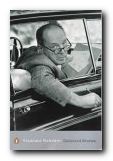a critical examination of Nabokov’s collected stories
 By the end of the 1930s, prompted by the threats of the Nazis, Nabokov had moved from Berlin to Paris – the second centre of Russian emigration. From there he was to travel even further westwards to America in 1940. Undoubtedly conscious of this growing exile from his native land, he turned back in 1939, for one of his last short stories to be written in Russian, to the topic he had treated in poems and stories many times before – the return to Russia. And for this occasion he chose to employ the form of the conte fantastique, a tradition in story-telling which goes back to Gautier and E.T.A. Hoffmann.
By the end of the 1930s, prompted by the threats of the Nazis, Nabokov had moved from Berlin to Paris – the second centre of Russian emigration. From there he was to travel even further westwards to America in 1940. Undoubtedly conscious of this growing exile from his native land, he turned back in 1939, for one of his last short stories to be written in Russian, to the topic he had treated in poems and stories many times before – the return to Russia. And for this occasion he chose to employ the form of the conte fantastique, a tradition in story-telling which goes back to Gautier and E.T.A. Hoffmann.
The narrator of ‘The Visit to the Museum’ (September 1938) has been asked by a friend to locate and purchase a portrait of his Russian grandfather which has found its way into a small provincial museum in France. The narrator is sceptical and reluctant, but when he visits the museum the portrait is there. Suddenly his interest is aroused: ‘It is fun to be present at the coming true of a dream, even if it is not one’s own’ (RB,p.70).
He applies to the curator for permission to purchase, but the curator denies the existence of the painting. The narrator bets him the money he has been given to make the purchase, and when they go to check the curator admits that he was wrong. But when the narrator presses his claim the curator disappears and the narrator becomes lost in a maze of rooms in the fantastically expanding museum.
Gradually he finds himself amongst familiar houses and streets, a light snow is falling, and he realises that he is back in Russia. It is not the Russia of his childhood however, but that of the present day under the Soviets. His dream turns into a nightmare, and he is forced to throw away everything which would identify him as a returned émigré. Then the story ends abruptly with a summary of subsequent events:
‘I shall not recount how I was arrested nor tell of my subsequent ordeals … it cost me incredible patience and effort to get back abroad, and … ever since I have foresworn carrying out commissions’ (p.79)
The formula is traditional enough – a transfer from one plane of reality to another and back again, though the ‘return’ is dealt with in so rapid and summary a fashion it seems that Nabokov is more interested in establishing the shock value of the initial transfer. It is this which gives rise to the principal problem with the story and the reason why it might have to be counted amongst his interesting failures.
The problem is the lack of relation between the first and the second part of the story. A realistic setting is established and the museum visit is perfectly credible, all in keeping with Nabokov’s normal manner of controlling narratives. Then along with the entrance of the curator, one or two mysteries are introduced: he resembles a Russian wolfhound, throws letters he has just written into a wastepaper basket, and does not know his own collection.
But none of these mysteries has any apparent connection with the portrait or the narrator’s subsequent experience in the museum where he wanders from rooms full of steam engines, railroad stations, and The Section of Fountains and Brooks, back into the reconstruction of the Soviet Union. The only element which unites the request, the portrait, narrator, curator, and the fantasy world is that they are all Russian. And these elements cohere only under the canopy of a ‘What if …?’ – the impossibility of recovering the Russian past.
In fictions of the conte fantastique variety we are usually offered some tantalising evidence of the fantasy world when the protagonist returns to the ‘real’ one. In Gautier’s ‘La Cafetiere’ as a typical instance, the narrator awakes from his reverie of dancing with the figures from paintings – but he has a fragment of the coffee pot from this other world beside him. No such evidence connects the two worlds of ‘The Visit to the Museum’.
Of course the story is not offered in a state of high seriousness, but it recalls The Thunderstorm in failing to make a convincing connection between realism and fantasy. It is as if Nabokov was not comfortable with this mode. He seems to operate at his best when straining against but staying within the bounds of literary realism.
© Roy Johnson 2005
![]() Vladimir Nabokov: The Collected Stories – Amazon UK
Vladimir Nabokov: The Collected Stories – Amazon UK
![]() Vladimir Nabokov: The Collected Stories – Amazon US
Vladimir Nabokov: The Collected Stories – Amazon US
Vladimir Nabokov web links
Vladimir Nabokov greatest works
Vladimir Nabokov criticism
Vladimir Nabokov life and works